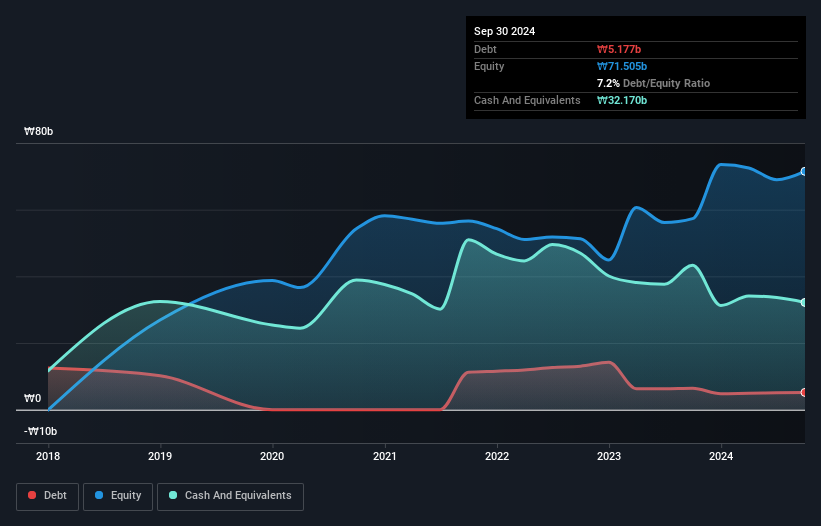Warren Buffett famously said, 'Volatility is far from synonymous with risk.' So it seems the smart money knows that debt - which is usually involved in bankruptcies - is a very important factor, when you assess how risky a company is. As with many other companies Saltlux Inc. (KOSDAQ:304100) makes use of debt. But is this debt a concern to shareholders?
What Risk Does Debt Bring?
Debt assists a business until the business has trouble paying it off, either with new capital or with free cash flow. In the worst case scenario, a company can go bankrupt if it cannot pay its creditors. While that is not too common, we often do see indebted companies permanently diluting shareholders because lenders force them to raise capital at a distressed price. Of course, the upside of debt is that it often represents cheap capital, especially when it replaces dilution in a company with the ability to reinvest at high rates of return. When we think about a company's use of debt, we first look at cash and debt together.
What Is Saltlux's Net Debt?
The image below, which you can click on for greater detail, shows that Saltlux had debt of ₩5.18b at the end of September 2024, a reduction from ₩6.42b over a year. However, it does have ₩32.2b in cash offsetting this, leading to net cash of ₩27.0b.

How Healthy Is Saltlux's Balance Sheet?
The latest balance sheet data shows that Saltlux had liabilities of ₩10.2b due within a year, and liabilities of ₩14.5b falling due after that. Offsetting these obligations, it had cash of ₩32.2b as well as receivables valued at ₩3.96b due within 12 months. So it actually has ₩11.4b more liquid assets than total liabilities.
This surplus suggests that Saltlux has a conservative balance sheet, and could probably eliminate its debt without much difficulty. Succinctly put, Saltlux boasts net cash, so it's fair to say it does not have a heavy debt load! The balance sheet is clearly the area to focus on when you are analysing debt. But it is Saltlux's earnings that will influence how the balance sheet holds up in the future. So when considering debt, it's definitely worth looking at the earnings trend. Click here for an interactive snapshot.
Check out our latest analysis for Saltlux
In the last year Saltlux wasn't profitable at an EBIT level, but managed to grow its revenue by 81%, to ₩50b. With any luck the company will be able to grow its way to profitability.
So How Risky Is Saltlux?
By their very nature companies that are losing money are more risky than those with a long history of profitability. And the fact is that over the last twelve months Saltlux lost money at the earnings before interest and tax (EBIT) line. Indeed, in that time it burnt through ₩8.4b of cash and made a loss of ₩3.3b. But the saving grace is the ₩27.0b on the balance sheet. That means it could keep spending at its current rate for more than two years. Saltlux's revenue growth shone bright over the last year, so it may well be in a position to turn a profit in due course. Pre-profit companies are often risky, but they can also offer great rewards. When analysing debt levels, the balance sheet is the obvious place to start. But ultimately, every company can contain risks that exist outside of the balance sheet. For instance, we've identified 2 warning signs for Saltlux (1 is significant) you should be aware of.
Of course, if you're the type of investor who prefers buying stocks without the burden of debt, then don't hesitate to discover our exclusive list of net cash growth stocks, today.
New: Manage All Your Stock Portfolios in One Place
We've created the ultimate portfolio companion for stock investors, and it's free.
• Connect an unlimited number of Portfolios and see your total in one currency
• Be alerted to new Warning Signs or Risks via email or mobile
• Track the Fair Value of your stocks
Have feedback on this article? Concerned about the content? Get in touch with us directly. Alternatively, email editorial-team (at) simplywallst.com.
This article by Simply Wall St is general in nature. We provide commentary based on historical data and analyst forecasts only using an unbiased methodology and our articles are not intended to be financial advice. It does not constitute a recommendation to buy or sell any stock, and does not take account of your objectives, or your financial situation. We aim to bring you long-term focused analysis driven by fundamental data. Note that our analysis may not factor in the latest price-sensitive company announcements or qualitative material. Simply Wall St has no position in any stocks mentioned.
About KOSDAQ:A304100
Saltlux
Operates as machine learning and natural language processing in South Korea.
Excellent balance sheet with minimal risk.
Market Insights
Community Narratives



